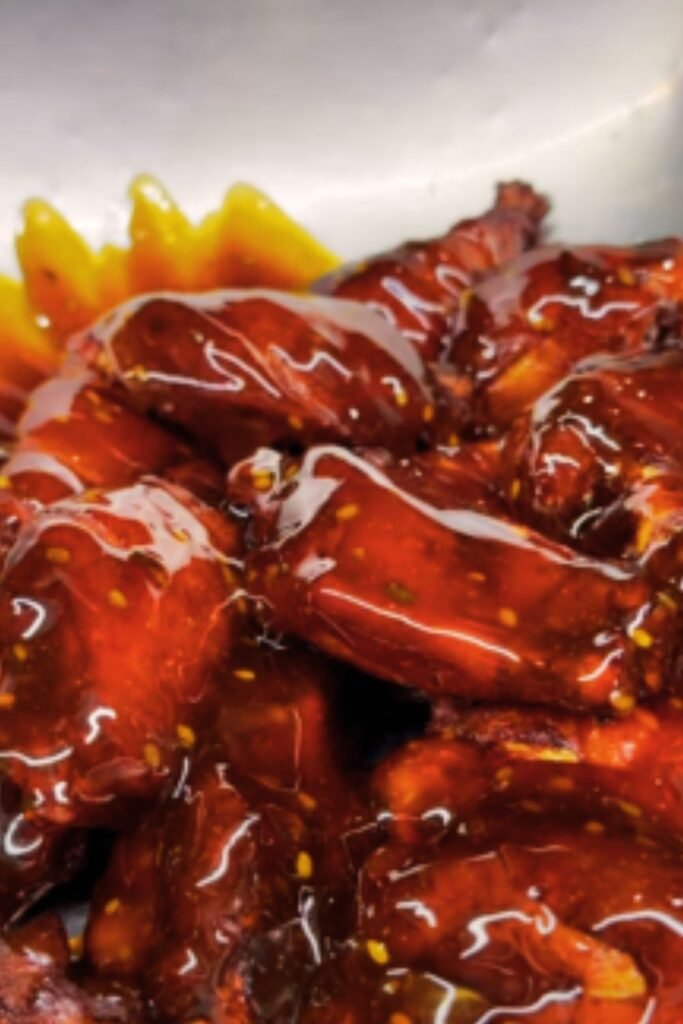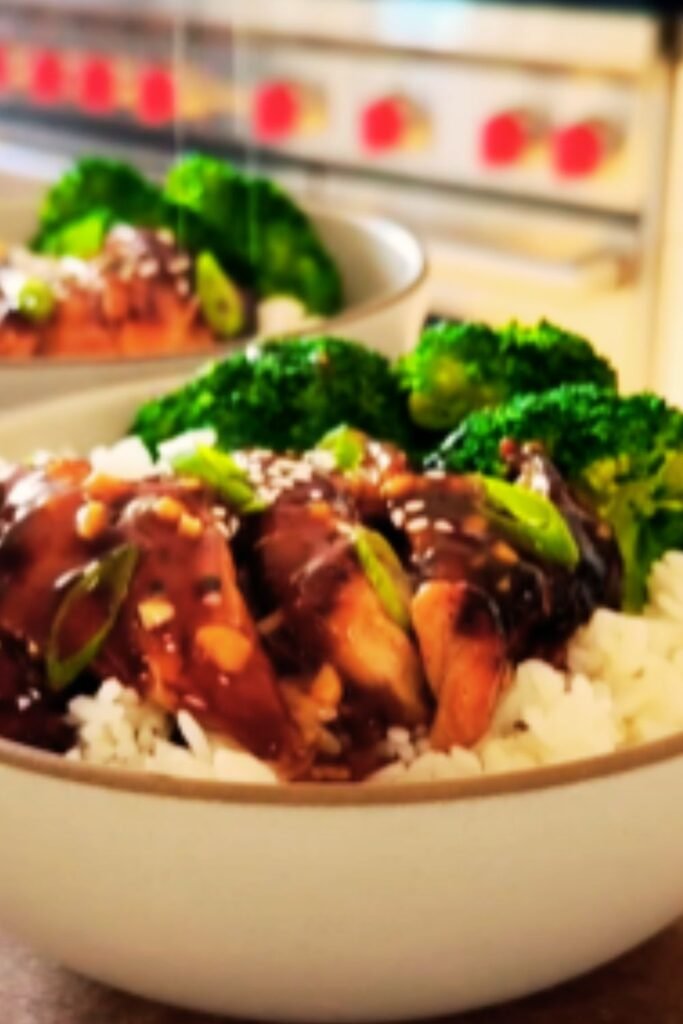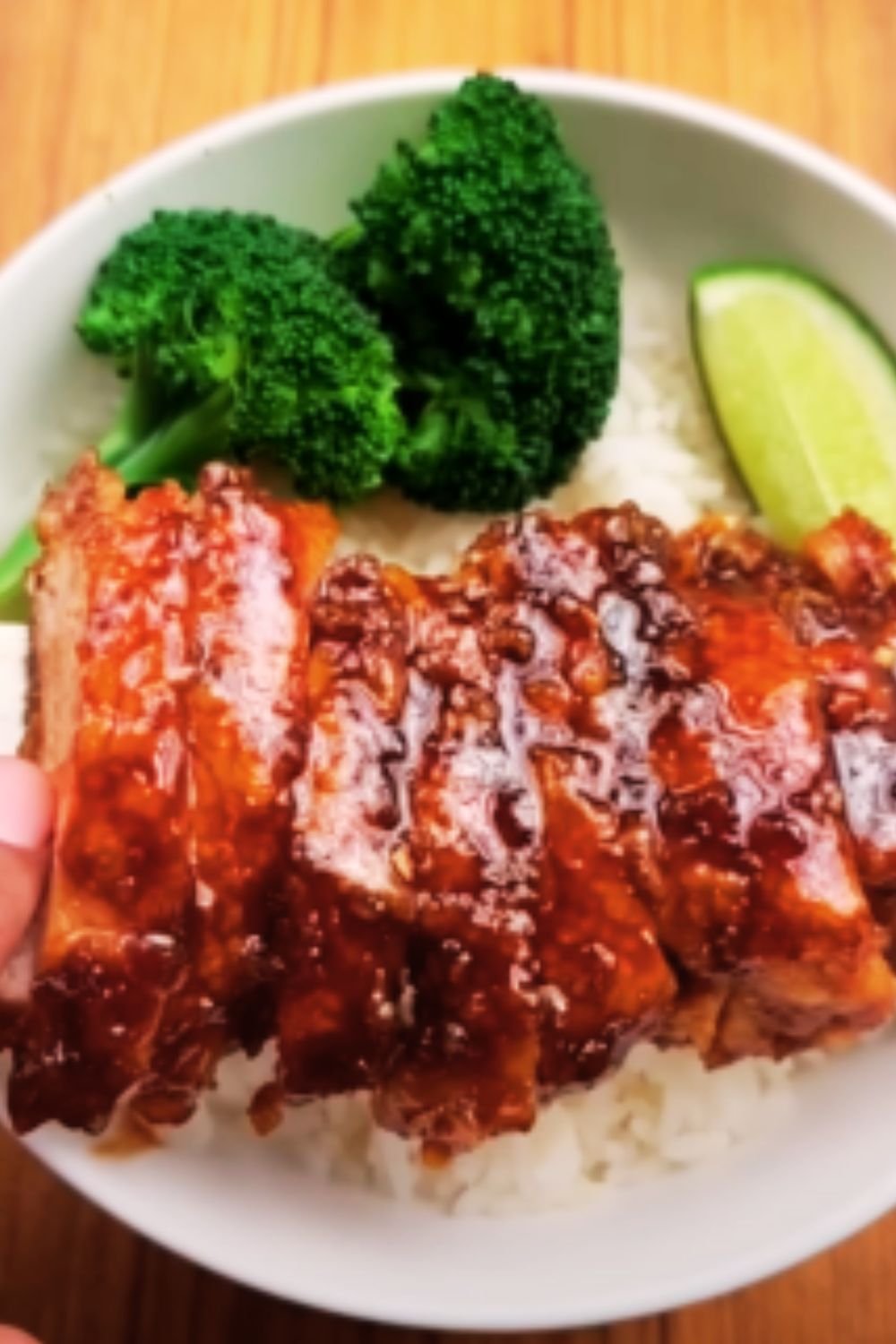There’s something absolutely magical about the combination of sweet and savory flavors dancing together on your palate. When I first attempted chicken teriyaki years ago, I was intimidated by what seemed like a complex Japanese dish. Today, I’m here to share that this restaurant-quality meal is surprisingly simple to master in your own kitchen.
Chicken teriyaki represents the perfect harmony of tender, juicy chicken glazed with a glossy, caramelized sauce that strikes the ideal balance between salty soy sauce and sweet mirin. The secret lies not just in the cooking technique, but in the marinade that transforms ordinary chicken into something extraordinary.
Understanding Teriyaki: More Than Just a Sauce
Teriyaki : A Japanese cooking technique where foods are broiled or grilled with a glaze of soy sauce, mirin, and sugar
Marinade : A seasoned liquid mixture used to flavor and tenderize meat before cooking
Mirin : A sweet Japanese rice wine with lower alcohol content than sake, essential for authentic teriyaki flavor
Tare : The concentrated sauce base used in Japanese cooking, which forms the foundation of teriyaki sauce
The beauty of chicken teriyaki lies in its simplicity. Unlike many complex dishes that require exotic ingredients or advanced techniques, this recipe relies on pantry staples that work together to create something truly special. My approach focuses on building layers of flavor through proper marination and careful sauce reduction.
The Science Behind the Perfect Marinade
Creating an effective marinade involves understanding how different ingredients interact with chicken proteins. The acidic components break down tough muscle fibers, while salt helps the meat retain moisture during cooking. Sugar elements contribute to beautiful caramelization and that signature glossy finish.
My marinade formula incorporates several key components that each serve a specific purpose. Soy sauce provides umami depth and acts as a tenderizer through its natural enzymes. Fresh ginger adds brightness and helps cut through the richness of the final dish. Garlic contributes aromatic complexity that complements the sweet elements perfectly.
The timing of marination is crucial. Too short, and you miss the tenderizing benefits. Too long, and the acid begins to make the meat mushy. I’ve found that 2-4 hours delivers optimal results, allowing flavors to penetrate while maintaining the chicken’s natural texture.

Essential Ingredients for Restaurant-Quality Results
For the Marinade and Sauce Base
| Ingredient | Amount | Purpose | Substitution Options |
|---|---|---|---|
| Soy Sauce (low sodium) | 1/2 cup | Primary umami base | Tamari, coconut aminos |
| Mirin | 1/4 cup | Sweetness and glaze | Rice vinegar + 1 tbsp sugar |
| Brown Sugar | 3 tablespoons | Caramelization | Honey, maple syrup |
| Fresh Ginger (grated) | 2 tablespoons | Aromatic brightness | 1 tsp ground ginger |
| Garlic (minced) | 4 cloves | Savory depth | 1 tsp garlic powder |
| Rice Vinegar | 2 tablespoons | Acidity balance | White wine vinegar |
| Sesame Oil | 1 tablespoon | Nutty richness | Vegetable oil |
| Cornstarch | 2 teaspoons | Sauce thickening | Arrowroot powder |
For the Chicken
| Component | Specification | Notes |
|---|---|---|
| Chicken Thighs | 2 lbs, boneless, skinless | Higher fat content stays juicier |
| Alternative Option | Chicken breasts, 1.5 lbs | Pound to even thickness |
| Preparation | Cut into 2-inch pieces | Uniform cooking |
Garnish and Serving
- Green onions (sliced thin)
- Sesame seeds (toasted)
- Fresh cilantro (optional)
- Steamed white rice
- Steamed vegetables
The quality of your soy sauce makes a significant difference in the final result. I always recommend using a good-quality, low-sodium variety to maintain better control over the saltiness. The reduced sodium content also prevents the chicken from becoming overly salty during the marination process.
Step-by-Step Preparation Method
Preparing the Marinade Base
I start by whisking together the liquid ingredients in a medium bowl. The key is ensuring the brown sugar completely dissolves before adding the other components. This prevents any granular texture in the final sauce and ensures even flavor distribution.
Grating fresh ginger releases more oils and provides better flavor integration than chopped pieces. I use a microplane grater for the finest texture, which distributes more evenly throughout the marinade. Fresh garlic should be minced finely to prevent any harsh bites in the finished dish.
Marinating the Chicken
Once my marinade is well combined, I reserve about 1/3 cup in a separate container for the cooking sauce. This prevents cross-contamination and ensures I have clean sauce for the final glaze. The remaining marinade goes into a resealable bag with the chicken pieces.
I make sure each piece of chicken is well-coated by gently massaging the bag. Then into the refrigerator it goes for at least 2 hours, though I prefer 4 hours for maximum flavor penetration. During this time, I occasionally flip the bag to ensure even marination.

The Cooking Process
When ready to cook, I remove the chicken from the marinade and let it come to room temperature for about 15 minutes. This ensures more even cooking and prevents the outside from overcooking while the inside remains underdone.
Heat control is critical for perfect teriyaki. I use medium-high heat in a large skillet or wok, adding a small amount of oil to prevent sticking. The chicken should sizzle immediately when it hits the pan, creating that beautiful caramelized exterior.
Cooking Techniques for Perfect Results
Initial Searing Phase
The first step involves achieving proper sear on the chicken pieces. I arrange them in a single layer, leaving space between each piece to prevent steaming. Overcrowding the pan results in soggy chicken instead of the desired caramelized exterior.
Each side needs about 3-4 minutes of undisturbed cooking time. Resist the urge to move or flip the chicken too early. You’ll know it’s ready to flip when it releases easily from the pan surface. This initial searing locks in juices and creates texture contrast.
Sauce Reduction and Glazing
Once the chicken is nearly cooked through, I add the reserved marinade to the pan. The liquid should immediately start bubbling and reducing. This is where the magic happens as the sugars caramelize and the sauce thickens into that glossy teriyaki glaze.
I whisk the cornstarch with a tablespoon of water to create a slurry before adding it to the pan. This prevents lumps and ensures smooth sauce consistency. The sauce should coat the back of a spoon when properly reduced.
Temperature and Timing Guidelines
| Cooking Stage | Temperature | Time | Visual Cues |
|---|---|---|---|
| Initial Sear | Medium-High | 3-4 min per side | Golden brown, releases easily |
| Sauce Addition | Medium | 2-3 minutes | Bubbling, starting to thicken |
| Final Glaze | Medium-Low | 1-2 minutes | Glossy, coats chicken |
| Internal Temp | 165°F (74°C) | Variable | Use meat thermometer |
The key to perfect teriyaki is patience during the sauce reduction phase. I keep the heat at medium to prevent burning while allowing proper caramelization to occur. The sauce should reduce by about half and become noticeably thicker.
Flavor Variations and Customizations
Heat Level Adjustments
For those who enjoy a bit of spice, I often add red pepper flakes or fresh sliced chilies to the marinade. Start with a small amount as you can always add more, but you can’t take it away. A teaspoon of sriracha or gochujang paste also works wonderfully.
Sweetness Modifications
The brown sugar can be adjusted based on personal preference. I sometimes substitute honey for a more floral sweetness or maple syrup for deeper complexity. Each sweetener brings its own character to the dish while maintaining the essential teriyaki profile.
Protein Alternatives
While chicken is traditional, this marinade works excellently with other proteins. Salmon, pork tenderloin, or even firm tofu can be substituted using the same marination and cooking principles. Adjust cooking times based on the protein’s specific requirements.

Serving Suggestions and Accompaniments
Traditional Presentations
I love serving chicken teriyaki over steamed jasmine rice, allowing the sauce to soak into the grains. The neutral rice provides the perfect canvas for the bold teriyaki flavors. A side of steamed broccoli or snap peas adds color and nutritional balance.
Modern Interpretations
For a contemporary twist, try serving the chicken over quinoa or cauliflower rice for a lighter option. Spiralized vegetables make an excellent low-carb base that still captures all the delicious sauce.
Presentation Tips
Garnishing makes a significant difference in the final presentation. I always finish with thinly sliced green onions and toasted sesame seeds. The green onions add a mild onion bite that complements the sweet-savory sauce, while sesame seeds provide textural interest and nutty flavor.
Storage and Meal Prep Strategies
Refrigeration Guidelines
Cooked chicken teriyaki keeps well in the refrigerator for up to 4 days when stored in airtight containers. The flavors actually improve after a day as they continue to meld together. I often make extra portions specifically for meal prep purposes.
Freezing Instructions
The dish freezes exceptionally well for up to 3 months. I portion it into individual servings before freezing, making it easy to grab a quick meal. Thaw overnight in the refrigerator and reheat gently to prevent the sauce from breaking.
Reheating Best Practices
When reheating, I add a splash of water or chicken broth to prevent the sauce from becoming too thick. Gentle reheating over medium-low heat maintains the sauce’s glossy appearance and prevents the chicken from becoming tough.
Nutritional Information and Health Benefits
Nutritional Breakdown (Per Serving)
| Nutrient | Amount | % Daily Value |
|---|---|---|
| Calories | 285 | 14% |
| Protein | 28g | 56% |
| Carbohydrates | 18g | 6% |
| Fat | 12g | 18% |
| Sodium | 890mg | 39% |
| Sugar | 15g | – |
| Fiber | 1g | 4% |
Health Considerations
Chicken teriyaki provides high-quality protein essential for muscle maintenance and growth. The dish contains beneficial compounds from ginger and garlic, both known for their anti-inflammatory properties. Using low-sodium soy sauce helps control sodium intake while maintaining flavor integrity.
For those watching sugar intake, the natural sugars in mirin provide sweetness with more complex flavors than refined sugar alone. The dish also contains selenium from the chicken, supporting immune function.
Troubleshooting Common Issues
Sauce Too Thin
If your sauce isn’t thickening properly, create additional cornstarch slurry using equal parts cornstarch and cold water. Add gradually while stirring to prevent lumps. Remember that the sauce continues thickening as it cools.
Overly Salty Results
This usually occurs from using regular soy sauce instead of low-sodium varieties. To balance excessive saltiness, add a bit more brown sugar or honey. In extreme cases, dilute with a small amount of water or unsalted chicken broth.
Dry Chicken
Overcooking is the primary culprit for dry chicken. Using a meat thermometer ensures you stop cooking at exactly 165°F. Chicken thighs are more forgiving than breasts due to their higher fat content.
Burnt Sugar Issues
If the sauce starts burning, immediately reduce heat and add a splash of water. This happens when the heat is too high during the reduction phase. Prevention involves maintaining medium heat and stirring frequently.
Questions and Answers
Q: Can I make this recipe ahead of time for meal prep?
Yes, chicken teriyaki is excellent for meal prep! I actually prefer making it a day ahead because the flavors develop and intensify. Store the cooked chicken in airtight containers in the refrigerator for up to 4 days. When reheating, add a splash of water to loosen the sauce and reheat gently over medium-low heat.
Q: What’s the difference between using chicken thighs versus chicken breasts?
Chicken thighs are my preferred choice because they stay juicier and more tender due to their higher fat content. They’re also more forgiving if you accidentally overcook them slightly. If you prefer chicken breasts, pound them to an even thickness and be extra careful not to overcook them.
Q: Can I substitute the mirin with something else?
Absolutely! If you can’t find mirin, mix 2 tablespoons of rice vinegar with 2 tablespoons of sugar as a substitute. You can also use dry sherry with a pinch of sugar, though the flavor will be slightly different. The key is maintaining that sweet-tangy balance.
Q: How do I know when the sauce has reduced enough?
The sauce is properly reduced when it coats the back of a spoon and has a glossy, syrup-like consistency. It should have reduced by about half from its original volume. The sauce will continue to thicken slightly as it cools, so don’t over-reduce it.
Q: Can I double or triple this recipe for a crowd?
Yes, but you’ll need to cook the chicken in batches to avoid overcrowding the pan. Overcrowding causes the chicken to steam rather than sear, preventing that beautiful caramelized exterior. Keep the first batches warm in a low oven while finishing the rest.
Q: Is there a way to make this recipe lower in sodium?
Use low-sodium soy sauce and reduce the amount slightly, then add more rice vinegar and ginger to maintain flavor complexity. You can also try coconut aminos as a soy sauce substitute, though the flavor will be milder and slightly sweeter.
Q: How long should I marinate the chicken?
The optimal marinating time is 2-4 hours. Less than 2 hours won’t allow the flavors to penetrate properly, while more than 8 hours can start to break down the meat texture too much, making it mushy. I find 4 hours hits the sweet spot for both flavor and texture.
Q: Can I cook this in the oven instead of on the stovetop?
Yes! Bake the marinated chicken at 400°F (200°C) for 20-25 minutes. Meanwhile, reduce the reserved marinade in a saucepan on the stovetop. Brush the reduced sauce over the baked chicken before serving. This method works especially well for larger quantities.
Q: What vegetables pair best with chicken teriyaki?
Steamed broccoli, snap peas, carrots, and bok choy are traditional choices that complement the flavors beautifully. For something different, try roasted brussels sprouts or grilled asparagus. The key is choosing vegetables that won’t compete with the bold teriyaki flavors.
Q: Can I make this recipe gluten-free?
Yes! Simply substitute the soy sauce with tamari (which is naturally gluten-free) or coconut aminos. Make sure your other ingredients like mirin don’t contain any wheat-based additives. The rest of the recipe remains exactly the same.
Creating perfect chicken teriyaki at home is entirely achievable with the right technique and quality ingredients. The combination of proper marination, careful cooking, and sauce reduction results in restaurant-quality results that will impress family and friends alike. This recipe has become a staple in my kitchen, and I’m confident it will become one in yours as well.
